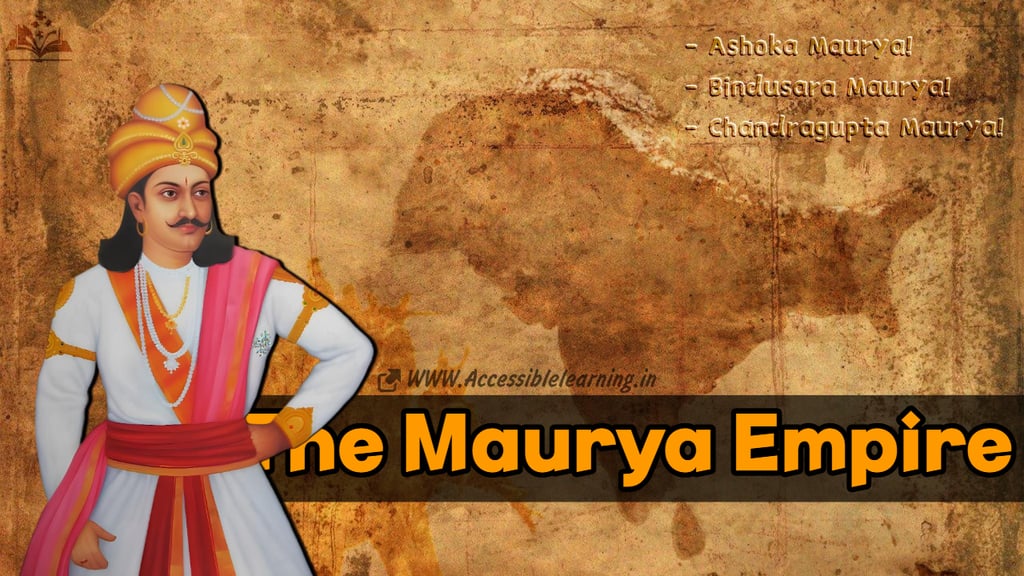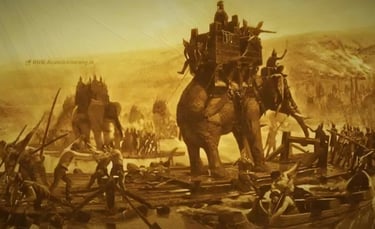
Ashoka the Great and the Golden Age of the Maurya Empire
The legacy of the Maurya Empire, an ancient Indian dynasty renowned for its political unification, economic prosperity, military strength, cultural contributions, and the spread of Buddhism under Ashoka the Great.
HISTORYINDIAN HISTORYEMPIRES/HISTORYEDUCATION/KNOWLEDGE
Sachin K Chaurasiya
2/1/20256 min read


The Maurya Empire stands as a monumental chapter in Indian history, showcasing an era of political unification, economic prosperity, and cultural brilliance. As one of the largest empires in ancient India, it laid the foundation for centralized governance and societal advancements. This article delves into the empire's origins, administration, notable rulers, achievements, and its eventual decline.
Origins of the Maurya Empire
The Maurya Empire emerged in 321 BCE under the leadership of Chandragupta Maurya (चन्द्रगुप्त मौर्य). With guidance from his mentor and advisor, Chanakya (चाणक्य) (also known as Kautilya or Vishnugupta/कौटिल्य या विष्णुगुप्त), Chandragupta overthrew the Nanda dynasty in Magadha, a region in modern-day Bihar. This event marked the beginning of the first pan-Indian empire, stretching from present-day Afghanistan and Pakistan in the northwest to Bengal in the east and the Deccan Plateau in the south.
Chanakya's Arthashastra (चाणक्य का अर्थशास्त्र), a treatise on statecraft, economics, and military strategy, served as the backbone of Mauryan administration. Its principles ensured the empire's efficient governance and economic stability.
Key Rulers and Their Contributions
Chandragupta Maurya (321–297 BCE)
Chandragupta (चंद्रगुप्त) was the founder of the Maurya Empire and a visionary leader. His collaboration with Chanakya allowed him to establish a robust centralized administration. Chandragupta defeated Seleucus I Nicator, a general of Alexander the Great, securing territorial expansions and fostering diplomatic relations through a marriage alliance. He later embraced Jainism and renounced his throne, spending his final years as an ascetic in Karnataka.
Bindusara (297–273 BCE)
Chandragupta's son, Bindusara (बिन्दुसार), further expanded the empire, earning the title Amitraghata (slayer of enemies). His reign was marked by stability and the continuation of his father's policies. However, historical records about Bindusara are limited compared to his predecessor and successor.
Ashoka the Great (273–232 BCE)
The most celebrated ruler of the Maurya Empire, Ashoka (अशोक), is renowned for his transformation from a conqueror to a compassionate leader. His early reign witnessed the brutal Kalinga War, which caused immense bloodshed and suffering. This event profoundly impacted Ashoka, leading him to embrace Buddhism and adopt Dhamma (a code of moral and ethical living).
Ashoka's edicts, inscribed on pillars and rocks, reflect his commitment to non-violence, social welfare, and religious tolerance.
His patronage of Buddhism played a significant role in its spread across Asia, influencing regions such as Sri Lanka, China, and Southeast Asia.
Under Ashoka, the Maurya Empire reached its zenith, both geographically and culturally.
Administration and Economy
The Maurya Empire's administrative structure was highly advanced for its time:
Centralized Governance: The emperor was the supreme authority, supported by ministers, provincial governors, and local administrators.
Provinces and Districts: The empire was divided into provinces, each governed by royal princes or trusted officials.
Revenue System: A well-organized taxation system funded public works, military campaigns, and administrative expenses.
Infrastructure: The Mauryas built an extensive network of roads, rest houses, and irrigation systems, enhancing trade and connectivity.
Legal System: The empire implemented a uniform legal framework, ensuring justice and equity across its territories.
The economy thrived on agriculture, trade, and industry. The empire engaged in both domestic and international trade, exporting textiles, spices, and precious stones to regions like Greece, Rome, and Southeast Asia. Major cities like Pataliputra (पाटलिपुत्र) (modern-day Patna) served as hubs of commerce, administration, and culture.
Cultural and Religious Contributions
The Maurya Empire was a melting pot of cultural and religious diversity. Hinduism, Jainism, and Buddhism coexisted, each contributing to the empire's spiritual and intellectual landscape.
Art and Architecture: The Ashokan pillars, with their intricate carvings and inscriptions, are enduring symbols of Mauryan craftsmanship. The Lion Capital of Ashoka at Sarnath, now India's national emblem, exemplifies their artistic brilliance. The construction of stupas like the Great Stupa at Sanchi reflected the empire's architectural advancements.
Buddhism: Ashoka's patronage led to the construction of stupas and monasteries and the dissemination of Buddhist teachings through missionaries and scholars. His efforts helped establish Buddhism as a major world religion.
Literature: While much of the Mauryan literary contributions have been lost over time, the Arthashastra (अर्थशास्त्र) remains a testament to their intellectual achievements in governance and economics.
Scientific Advancements: The Mauryan era saw developments in fields such as medicine, metallurgy, and astronomy, which laid the groundwork for subsequent innovations.


Military Prowess
The Maurya Empire maintained a formidable military force, which was instrumental in its expansion and control.
Army Composition: The army included infantry, cavalry, chariots, and war elephants. War elephants, in particular, were a distinctive feature of Mauryan military strategy.
Fortifications: Key cities and strategic locations were fortified, ensuring the empire's defense against external invasions.
Espionage: A well-organized network of spies, as described in the Arthashastra, played a crucial role in maintaining internal stability and gathering intelligence on enemies.
Navy: Though not as prominent as the army, the Mauryan navy facilitated trade and safeguarded coastal territories.
Decline of the Maurya Empire
The Maurya Empire began to decline after Ashoka's death in 232 BCE. Weak successors, internal conflicts, and administrative inefficiencies weakened the central authority. The vastness of the empire made it difficult to manage, and regional governors gained autonomy. The final blow came in 185 BCE when the last Mauryan ruler, Brihadratha, was assassinated by his general, Pushyamitra Shunga, who established the Shunga dynasty.
Other factors contributing to the decline included economic challenges, foreign invasions, and a gradual shift in trade routes, which affected revenue. Despite its fall, the Maurya Empire left a lasting legacy. Its political and administrative models influenced subsequent Indian kingdoms, while its cultural and religious contributions resonated far beyond the subcontinent.
Legacy of the Maurya Empire
The Maurya Empire represents a golden age in Indian history, marked by political unity, economic prosperity, and cultural enrichment. Its emphasis on governance, welfare, and moral values set a precedent for future civilizations. Ashoka's ideals of non-violence and religious tolerance continue to inspire global leaders and thinkers.
In modern times, the Mauryan legacy lives on through India's national emblem, the Ashokan Lion Capital, and the principles of inclusivity and governance that shaped the nation's ethos. The empire’s contributions to art, architecture, and religion remain enduring symbols of its greatness.
Additionally, the Maurya Empire's role in spreading Buddhism across Asia has left an indelible mark on global history, fostering intercultural exchanges and philosophical dialogues that resonate even today.


Interesting Facts About Emperor Ashoka and the Maurya Empire
Facts About Emperor Ashoka
The Kalinga Transformation
The Kalinga War (circa 261 BCE) was one of the bloodiest battles in Indian history, with over 100,000 people killed. Witnessing the immense suffering, Ashoka renounced violence and embraced Buddhism, transforming into a compassionate ruler advocating non-violence (ahimsa).
Pioneer of Dhamma
Ashoka’s Dhamma wasn’t tied to any single religion. It was a set of ethical principles promoting kindness, tolerance, animal welfare, and respect for all faiths. His policies were ahead of their time, focusing on moral governance and public welfare.
Global Spread of Buddhism
Ashoka sent Buddhist missionaries to Sri Lanka, Southeast Asia, and even as far as Egypt and Greece, playing a crucial role in making Buddhism a global religion. His son Mahinda and daughter Sanghamitra are credited with introducing Buddhism to Sri Lanka.
Ashokan Edicts
Ashoka left behind inscriptions on rocks and pillars, known as the Ashokan Edicts, which proclaimed his policies and moral teachings. These inscriptions, written in Brahmi and Kharosthi scripts, were among the earliest written records in India.
The Lion Capital
The Lion Capital of Ashoka at Sarnath, featuring four lions standing back-to-back, is now India’s national emblem and symbolizes power, courage, pride, and confidence.
Facts About the Maurya Empire
India's First Unified Empire
The Maurya Empire was the first to politically unify the Indian subcontinent, stretching from modern-day Afghanistan and Pakistan in the northwest to Bengal in the east and Tamil Nadu in the south.
Largest Empire of Its Time
At its peak under Ashoka, the Maurya Empire was one of the largest in the world, covering over 5 million square kilometers.
Sophisticated Administration
The Mauryas implemented a highly centralized government with an efficient bureaucracy. Chanakya’s Arthashastra served as a guiding manual for statecraft, diplomacy, and economic management.
Innovative Economy
The empire had a robust economy driven by agriculture, trade, and industry. The Mauryan rulers established an intricate taxation system and built extensive road networks to facilitate trade and communication.
Mauryan Military Prowess
The Maurya army was one of the most powerful in the ancient world, featuring war elephants, chariots, cavalry, and infantry. War elephants were a distinctive feature that gave them a strategic advantage in battles.
Cultural Syncretism
The Maurya Empire was a melting pot of cultures, with influences from Persian, Greek, and Indian traditions. This diversity enriched its art, architecture, and religious practices.
Pioneers of Welfare State Concepts
The Maurya rulers, particularly Ashoka, focused on public welfare by building hospitals, rest houses, and irrigation systems. Ashoka even created veterinary clinics for animals.
Legacy of Tolerance
Religious tolerance was a hallmark of the Maurya Empire, with Ashoka promoting peaceful coexistence among Hindus, Buddhists, and Jains.
Subscribe To Our Newsletter
All © Copyright reserved by Accessible-Learning Hub
| Terms & Conditions
Knowledge is power. Learn with Us. 📚


